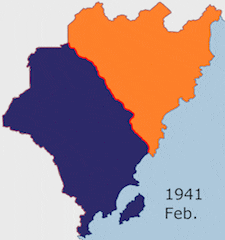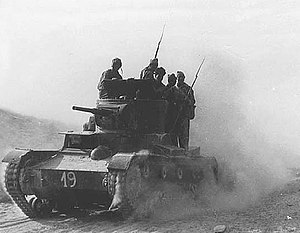User:BobOrson/Sandbox2
| Vinalian Struggle | |||||||
|---|---|---|---|---|---|---|---|
 Northern trucks in Mollas | |||||||
| |||||||
| Belligerents | |||||||
|
Supported by |
Supported by | ||||||
| Commanders and leaders | |||||||
|
|
| ||||||
| Strength | |||||||
| 2,000 |
| ||||||
| Casualties and losses | |||||||
| 500~ |
| ||||||
|
10,000–20,000 killed overall ≥1,000,000 internally displaced & ≥200,000 refugees | |||||||
The Second Vinalian Civil War, was a war between North Vinalia, and South Vinalia between 1941-1942. The war is the deadliest with some 150,000 casualties out of all the conflicts fought between both Vinalia's in the period known as the Vinalian Struggle, which saw both nations pitted against each other from 1933 with the First Vinalian Civil War until 1987 with the 12 Day War.
The conflict having it's origins in the chaos of the Chistovodian Revolution, and the subsequent independence of North Vinalia, and it's immediate conflict with the south. The conflict was seen as the first major conflict in the Asteria's following the Great War, and saw international aid be granted to both sides, in what became a new battlefield for the great powers of the region and the world.
Prelude
The Chistovodian Civil War had exploded in 1928, at first sec
First Vinalian Civil War (1933-1935)
With victory in Chistovodia secured the People's Army turned their attention to the south of the nation, where former Babych supporters had congregated, along with anti-socialist militias. With Chistovodian support, North Vinalian forces attempted to reconquer the south in 1933 with the Mollas Offensive, North Vinalian forces were unable to breakthrough and both nations settled into a 2 year long stalled war. Repeated Northern attempts were met with strong southern defences and by 1935 the war had grown unpopular with the Northern population, and peace was reached between both states. The south still claiming the entirety of the former Chistovodia settled for the establishment of a democratic Vinalian government, establishing the Republic of Vinalia.
Border disputes arose immediately as hundreds fled from the north to the south of the nation fearing purges, many Vinakians sought to escape to the north likewise fearing reprisals for their aiding of northern groups during the civil war. Tensions between both nations had escalated following the large scale acquisition of foreign equipment from excess stores following the Great War by both sides. Support for the North was far more stable as it was able to secure Swetanian equipment with ease, and at low prices, while the South struggled to obtain equipment from foreign nations. The South instead hoped it’s superior numbers, and nations opposed to growing Socialist growth in the Asterias would come to it’s aid, Marirana provided some aid to the South, fearful of what a Socialist Vinalia could bring to the country.
Second Vinalian Civil War (1941-1942)
Planning
In December 1940 Southern intelligence had learned of the acquisition of Swetanian made tanks, which troubled the South fearful the North was gearing up for an invasion as soon as the tanks were able to operate in Northern hands. Yankul Kamenov, had approved the initial planning of a pre emptive strike against the North to destroy their ability to conduct an invasion of the South. Seeking to conduct the movement of forces in full secrecy units were told to march northwards with no clear instructions, to hide the conscription of soldiers, and the raising of the reserves the announcement of a wide scale infrastructure project in mid January, told the story of the Southern government utilizing military labor to build infrastructure to hide the movement of some 20,000 active personnel including all of the Souths armor, and the mobilization of some 15,000 reservists.
The conduct of this operation proved an absolute success, Southern forces had moved some 35,000 men, 300 vehicles, 500 artillery pieces, and 25 planes to the Northern border with little to no notice by Northern intelligence. Reports from the National Defence Unit (NDU), reported that Southern units were in movement but towards allowing large scale leaves for it’s soldiers, in what some Northern analysts called a great opportunity for the North to attack weakened Southern defences.
Southern forces had concentrated into two major attacks, one aimed North with the goal of securing Mollas in the deep North, and another aimed at cutting the city of Norelinsk from the rest of the North. The operation would involve some 100,000 men, along with 500 vehicles, 1000 artillery pieces, and 100 planes, they were to face a Northern contingent of some 60,000 men, no vehicles, and some 500 artillery pieces, with 40 planes. Northern units numbering some 80,000 and all their vehicles had been pulled back in early January for training and refitting further upnorth, as they prepared for an attack in the South upon the arrival of spring.
1941
Southern forces struck on the morning of the 1st of February, with Southern aircraft attacking and engaging Northern aircraft and airfields with ease. Border forces had been caught completely off guard and were soon over run, 5,000 soldiers were encircled near the city of Durassa, Norelinsk had also been cut off, as Northern casualties number 15,000 men during the first week. By mid February the entirety of the Northern army was in full retreat for the coast and further north, with Norelinsk being surrendered the 11th of February with 3,000 soldiers caught inside. The rapid advance by Southern forces attracted attention by many foreign observers, do to the speed at which the South had struck.
Southern advance began to slow as Northern elite units were thrown to prevent further breakthrough, the Vinalian coast saw desperate fighting as Northern forces attempted to retreat before they could be cut off. Southern forces had entered Mollas the 3rd of March, facing virtually no resistance from it’s defenders, continuing their push up north seeking to encircle the 15,000 men caught between their lines and the Vinalian coast. By the 14th of March however, two large pockets had been created, some 5,000 men trapped in the city of Virin, and some 7,000 men trapped in the Vraw peninsula. Southern forces began the process of consolidating their lines, facing strong resistance from guerrilla groups in the occupied North and in the south, with the Vinakian Liberation Army conducting attacks against Southern installations in Nazica, Apajia, and Velkarichka.
The Socialist world fearing the collapse of North Vinalia do to the rapid advance by the south jumped in, Swetanian regulars disguised as volunteers arrived alongside Northern bought vehicles, Chistovodian units had also crossed the border and entered into the North. By April these foreign units had been placed alongside the 140,000 strong Vinalian army, made up of some 50,000 conscripts, and 60,000 militias, alongside what remained of the regular army. Southern forces had concentrated and readied themselves for a push directly against Chervona, Kamenov hoped that by capturing Chervona the North would collapse. The south renewed it's push with the 20,000 strong elite 35th Army the 8th of April, Northern forces were initially broken through with great success, this caused concern for the Swetanians under SWETANIAN GENERAL, Swetanian driven tanks were rushed to the breakthrough and were able to stop the Southern push, the ensuing battle the 12th resulted in a Southern stop and latterretreat having suffered some 3,000 casualties. Taking advantage of the situation the 15th Swetanian forces launched a limited offensive forcing Southern forces back and reinforcing the Northern line.
Southern forces had been held back and began to plan for an attack to avoid the ever strengthening defensive positions in front of Red Bay. Some 30,000 men began to be moved along with most vehicles further west, Southern forces were unable to match their success in hiding the movement of the forces as they had before, and Northern intelligence was well aware of their movements. Northern forces had been put under the command of Nazar Holovko, Nazar began to set forth a major offensive in June, before the South could launch it's own attack
peace talks were held in Cuanstad, Imagua to discuss a formal end to the war, the Cuanstad agreement laid out a ceasefire agreement between both sides, with North Vinalia refusing to recognize Southern gains during the war. Following a Northern offensive from the 15-25th of September the Northern forces held a considerable advantage having encircled Norelinsk, and with the South not seeking to repeat a siege like it had in Mollas it agreed to the current frontline being marked as the border with all territory in the now Norelinsk pocket surrendered to the North the 9th of October ending the war. A Community of Nations peacekeeping mission CONVMO I, was established in the border to ensure the agreements were kept. With a demilitarized zone between both states being enforced.




